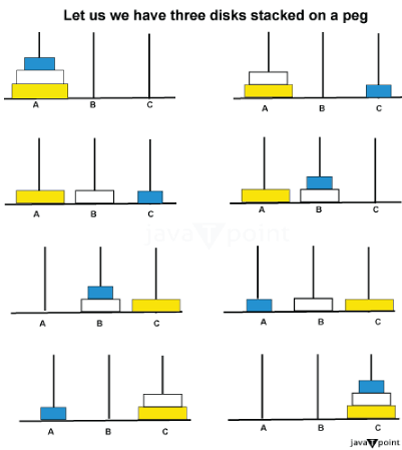Tower of Hanoi Program in JavaThree discs with different diameters and a pair of pegs make up the well-known mathematical puzzle known as the Tower of Hanoi. The objective of the puzzle is to move each disc between pegs in accordance with the instructions listed below:
In this section, we will examine a Java implementation of the Tower of Hanoi issue. We will divide the problem into manageable chunks and offer a thorough description and the related code for each step. 
Step 1: Define the Tower of Hanoi Method Initially, we must develop a recursive solution for the Tower of Hanoi problem. The following parameters should be included in the method:
Here's the method signature: Step 2: Define the Base Case One well-known example of a recursive issue is the Tower of Hanoi problem. For a recursive problem to end, there needs to be a base case. In this case, the base case occurs when there is only one disk to be moved. Step 3: Move n-1 Disks to the Auxiliary Peg First, we must transfer n-1 discs from the source peg to the auxiliary peg in order to solve the Tower of Hanoi issue for n discs. A recursive call to the towerOfHanoi() method is required for this stage. Step 4: Move the Largest Disk to the Destination Peg Once we have moved n-1 disks to the auxiliary peg, we can move the largest disk from the source peg to the destination peg. Step 5: Move the n-1 Disks from the Auxiliary Peg to the Destination Peg Finally, we need to move the n-1 disks from the auxiliary peg to the destination peg. Again, this step involves a recursive call to the towerOfHanoi method. Tower of Hanoi Java ProgramTowerOfHanoi.java Output: Move disk 1 from A to C Move disk 2 from A to B Move disk 1 from C to B Move disk 3 from A to C Move disk 1 from B to A Move disk 2 from B to C Move disk 1 from A to C Explanation The toh() method base case occurs when there's only one disk (n ==1), prompting it to display the action of transferring the disk from the source peg to the destination peg. In the case of more than one disk, the toh() method utilizes recursion to address the Tower of Hanoi problem. It initiates by moving n-1 disks from the source peg to the auxiliary peg, utilizing the destination peg as an auxiliary. Following that, it transfers the nth disk from the source peg to the destination peg. Finally, the method recursively handles the n-1 disks, moving them from the auxiliary peg to the destination peg while employing the source peg as the auxiliary.
Next TopicTwo Types of Streams Offered by Java
|
 For Videos Join Our Youtube Channel: Join Now
For Videos Join Our Youtube Channel: Join Now
Feedback
- Send your Feedback to [email protected]
Help Others, Please Share









